3 Easy Ways To Trim Your Dog's Nails
3 Easy Ways To Trim Your Dog's Nails
The length of your dog's nails is something that is often overlooked. However, this actually plays a very important role in your dog's general health and wellbeing. Dogs whose nails are allowed to be long are likely to have painful toe joints and even issues with their posture and alignment if this goes on for prolonged periods.
Even if long nails do not get split or torn whilst your dog is moving around, they are still likely to be very uncomfortable for your dog. Each time their nail comes into contact with the floor beneath them, this exerts force back into the nail bed and into the toe joints and foot. I imagine it must feel a bit like wearing shoes which are slightly too small, which is definitely something you would want to avoid!
Thankfully, it can be relatively straight forward to maintain your dogs nail health at home. Using careful introductions and lots of positive reinforcement, most dogs tolerate having their nails handled and trimmed quite well. You can read more about the benefits of introducing Co-operative Care training to your dog here.
Below are the 3 most common methods used to successfully maintain your dog's nails:
1. Nail Clippers
Nail clippers are probably the most popular method of trimming your dog's nails. When introduced and used correctly, they often have good results, though care must be taken not to trim the nail too far back, which can make them bleed. This is especially important for dog's whose nails are darker or black coloured as it makes it difficult to see where the nail's blood supply is.
Guillotine nail clippers are another option which are best suited to smaller dog's with thinner nails usually. With these, the dog's nail is placed through the central hole of the clippers and the blades surround the nail when the handled are squeezed. This gives a similar result to the more traditional scissor type clippers.
2. Nail Grinders
Nail grinders are growing rapidly in popularity amongst dog lovers. They are especially useful for those of us with larger breeds of dog whose nails tend to be thicker. Grinders also provide a smoother finish overall as they do not leave any sharp edges as clippers sometimes can.
They can take a lot of getting used to for both the dog and the operator though, so you will need to ensure that the process is not rushed. Your dog will need to be desensitised to the noise and vibrations made by the grinders, to make sure they are not scared of them.
3. Scratch Boards
Scratch boards are a useful tool to have available as they allow your dog to maintain their own nail length without your intervention. They can be purchased ready made or you could make your own by covering a wooden board in coarse sandpaper.
You simply have to encourage your dog to scratch at the board with their feet and reward them for doing so. This is definitely easier to teach with your dog's front feet, but you can teach them to do their back feet too even though this is undoubtedly more difficult.
The scratch board can be left flat on the floor, or angled in order to achieve the desired nail shape and length. You may also find it useful to use an emery board/nail file to finish off each nail as well.
By teaching your dog to be comfortable having their nails handled and clipped at home, you can avoid the potential stress and expense of vet visits for the same result. Anything we can do to make our dog's lives easier and less stressful has got to be worth doing! Right?
To read more about co-operative care training you can read my blog here.
You can also sign up to my mailing list to receive all the latest updates here.






Comments
Post a Comment